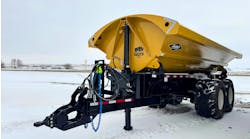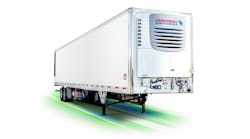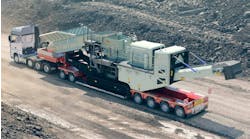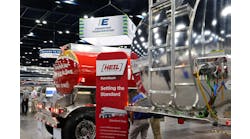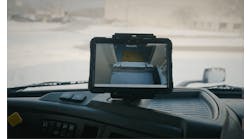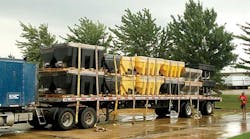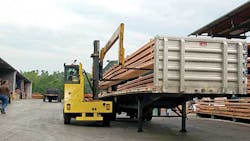A flatbed trailer is an entirely different animal than a van trailer. Mistakes that can be hidden in a van can’t be hidden on a flatbed.
Failure to properly secure cargo or equipment on a commercial vehicle is the fourth-leading violation—after brakes, lights, and tires—that causes vehicles to be placed Out-of-Service (OOS). It was a focus during Roadcheck 2015 in June when inspectors were checking vehicles for all violations.
With that in mind, Jeff Luick, a sales executive at Kinedyne LLC, stresses the importance of reviewing the Federal Motor Carrier Safety Administration’s (FMCSA) cargo securement regulations and the cargo securement regulations for the state/province and country in which you are operating.
“Safety is no accident,” says Luick, who operates a Cargo Securement Regulation Training program. “Use good-quality, brand-new cargo-control products. Know rules and regulations. That will keep you within the law and ensure a safe trip for you guys and the traveling public.”
He says proper cargo securement means doing what it takes to ensure that cargo stays put. To do this, it helps to understand the forces that might cause cargo to shift, slide, or fall off the bed. Understanding these forces and how they act will help people to understand the reasoning for the regulations. Operators must be confident that the methods used to secure their load are going to be strong enough to withstand the forces of any emergency braking or evasive maneuver they might have to make out on the road.
“We all know from experience that does happen occasionally, probably more often than we would like,” he says. “Not all motorists are under the forces involved. Sometimes you are unintentionally cut off and may have to make a quick stop. So it’s important that cargo securement is in good shape and tightened up properly.”
He went through some FMCSA regulations:
• Lateral Forces § 393.102(a).
Lateral forces will move an item sideways, forward, backward, or in any two of these directions at once. Cargo securement standards require all cargo to be secured to withstand force in a forward direction: 0.8g or 80% of the cargo weight. The cargo-securement system must be able to resist a side-to-side force equal to 0.5g or 50% of cargo weight.
Force in a rearward direction occurs when a vehicle accelerates, shifts gears while climbing a hill, or brakes in reverse. Cargo securement system must be able to resist force equal to .5g or 50% of cargo weight.
Force in an upward direction occurs when a vehicle is traveling over bumps in the road or cresting a hill. A cargo-securement system must be able to resist force equal to .2g or 20% of cargo weight (unless cargo is fully contained).
Use of any one or combination of the following: vehicle structure, securement devices, or blocking and bracing. Attachment points if using a vehicle structure: floors, walls, decks, headboards, rub rails. Place cargo against: headboard, bulkhead, stakes, or other vehicle structures.
The equipment and method used must meet the applicable standard. Below are points that should be considered when securing cargo: weight, length, size, shape, strength, characteristics.
• Application to Cargo Securement Regulations § 393.100(a).
Subpart 1: Protection Against Shifting and Falling Cargo.
Applicability: The rules in this subpart are applicable to trucks, truck tractors, semitrailers, full trailers, and pole trailers. Prevention against loss of load: Cargo must be contained, immobilized, or secured in accordance with this subpart to prevent shifting upon or within the vehicle.
• Performance Criteria – Breaking Strength § 393.102(e).
Tie-down assemblies (including chains, wire rope, steel strapping, synthetic webbing, and cordage) and other attachment or fastening devices used to secure articles of cargo to, or in, commercial motor vehicles must be designed, installed, and maintained to ensure that the maximum forces acting on the devices or systems do not exceed the manufactures breaking strength rating under the following conditions: .8g deceleration in the forward direction; .5g acceleration in the rearward direction; .5g acceleration in the lateral direction.
• Performance Criteria—Working Load Limit § 393.102(a).
Tie-down assemblies (including chains, wire rope, steel strapping, synthetic webbing, and cordage) and other attachment or fastening devices used to secure articles of cargo to, or in, commercial motor vehicles must be designed, installed, and maintained to ensure that the maximum forces acting on the devices or systems do not exceed the manufactures working load limit rating under the following conditions: .435g deceleration in the forward direction; .5g acceleration in the rearward direction; .25g in the lateral direction.
Determining Working Load Limit (WLL): This is the maximum amount of load that can be applied to a piece of equipment—winch strap, ratchet strap, chain, lever, or ratchet binder. This information is assigned to the product by the manufacturer.
He said Kinedyne’s products have a Webbing Breaking Strength that is three times the WLL and a Chain Breaking Strength that is four times the WLL.
“That’s because you need that built-in safety factor for anything you might run into on the road—a quick stop, going around a corner a little too fast,” he says. “You’re putting a lot of G-force onto the load. This gives you extra margin of error so you don’t have failure. The other thing is that the inspector is going to work off WLL, not braking strength. When you’re tying down a piece of equipment, you need 50% of the gross load weight in cargo control to meet the standard. That’s where I see violations happening where people can get into trouble.”
• The Use of Tie-downs § 393.104(f).
Tie-downs and securing devices must not contain knots. Each tie-down must be secure in a manner that prevents it from becoming loose, unfastened, opened, or releasing while the vehicle is in transit.
Edge protection must be used whenever a tie-down would be subject to abrasion or cutting at the point of contact with the cargo.
“Sometimes it’s a pain, but when you get a ratchet strap on a load and you’re tightening from one side, you’re actually putting uneven pressure on the load as you’re tightening it down,” he says. “If you use a corner protector, it allows that strap to slide and adjust so you have even pull on a load.”
• General Requirements for Securing Articles of Cargo §393.106 (b & c).
Cargo must be firmly immobilized or secured on or within a vehicle by structures of adequate strength, dunnage, shoring bars, tie-downs, or a combination of these. Articles of cargo that are likely to roll must be restrained by wedges, a cradle, or other equivalent means to prevent rolling. The means of preventing rolling must not be capable of becoming unintentionally unfastened. Articles of cargo placed beside each other and secured by transverse tie-downs must either be placed in direct contact with each other or be prevented from shifting towards each other.
• Aggregate Working Load Limit for Tie-Downs §393.106 (d) – Direct Tie-Downs.
The aggregate working load limit for tie-downs used to secure an article against movement must be at least one-half times the weight of the article or articles.
The aggregate working load limit is the sum of: one-half the working load limit of each tie-down from an anchor point on the vehicle to an anchor point on the article of cargo; one-half the working load limit of each tie-down that goes from an anchor point on the vehicle, passes through, over, or around the article of cargo and is then attached to the same side of the vehicle.
• Aggregate Working Load Limit for Tie-Downs §393.106 (d) – Indirect Tie-Down.
The aggregate working load limit for tie-downs used to secure an article against movement must be at least one-half times the weight of the article or articles.
The aggregate working load limit is the sum of: the full working load limit for each tie-down that goes from an anchor point through, over or around the article of cargo and then attaches to another anchor point on the other side of the vehicle.
• Tie-Downs Required to Secure a Load § 393.110.
Length and weight—no bulkhead: one tie-down for articles five feet or less in length, and 1100 lbs or less in weight; two tie-downs if the article is five feet or less in length and more than 1100 lbs; two tie-downs if the article is longer than five feet and less than or equal to 10 feet; two-tie-downs if the article is longer than 10 feet and one additional tie-down for every 10 feet beyond the first 10 feet of article length or fraction thereof.
• Tie-downs Required to Secure a Load § 393.110.
Length and weight—bulkheaded: If an individual article is blocked, braced or immobilized to prevent movement by a header board, bulkhead, or other articles which are adequately secure, or by appropriate blocking or immobilization method, it must be secured by one tie-down every 10 feet of article length or fraction thereof.
Unitized loads: Bundles that are 10 feet (3.04m) need only one tie-down in the first 10 feet (3.04m) when blocked and need two tie-downs in the first 10 feet (3.04m) when not blocked.
Note: Repairs. Webbing used in tie-down assemblies shall not be repaired or spliced.
“We get a lot of questions about this,” he says. “People want to take it and repair it themselves or ask us to do it. When we sew an assembly together, that sew pattern is a load-bearing pattern. So you don’t want to give it to your grandmother and have her sew it. You’re potentially putting yourself in a liability situation. Those patterns are designed to be load-bearing.”
Webbing straps must be protected when used on rough or sharp objects. Straps that are cut, worn or damaged shall not be used and shall be replaced immediately. All strap assemblies shall be inspected prior to each use. The use of “Cheater Bars” or other means of increasing leverage on a ratchet buckle handle, chain binder or winch, other than a Kinedyne-approved device, can cause serious injury to the user and/or bystander, he says.
Grade 70 chain is a higher strength, heat-treated, carbon-steel chain typically used by the trucking industry, loggers, and highway crews. Grade 70 chain WLLs are approximately 20% higher than Grade 43.
Chain inspection—what to look for: bent or twisted chain links, stretched, worn, heat damage or nicked chain links. If any of the above defects are identified, immediately remove from service.
• The Rules for Metal Coils § 393.120.
Metal coils roll easily if they are not secured properly. The method used must prevent all movement of the coils, because of their size and weight. Even slight movement can be dangerous. Coils can quickly develop momentum that can snap tie-downs.
• Securing Metal Coils § 393.120(a).
Coils can be loaded one of three ways: eyes lengthwise; eyes vertical; eyes crosswise.
Eyes crosswise: maintain low angles on direct tie-downs; do not over-tighten tie-downs; the angle between a direct tie-down and the deck should always be less than 45 degrees; use edge protectors or channel guides when securing metal coils; it is recommended to use a friction mat; coil must be secured to pallet to withstand all forces in the Performance Criteria; the sum of WLLs of all tie-downs must be at least 50% of weight of coils, based on requirements.
Eyes lengthwise: two tie-downs directly attached through the eye of the coil and one tie-down traversed over the eye, or two tie-downs that pass over front and rear of coil. If a steel coil weighs 10,000 lbs, the load securement method must provide 8000 lbs of tie-down securement. This requirement prevents movement in the forward direction, which is expressed as 80% of the cargo weight or 0.8g. Each coil must be secured by means of timbers, chocks, wedges or cradle to prevent the coil from rolling. The means of preventing movement must support the coil off the deck and must not be capable of becoming unintentionally unfastened or loose while the vehicle is in transit. If timbers, chocks or wedges are used, they must be held in place by coil racks, bunks or similar devices to prevent them from coming loose.
“These are the federal regulations—states and countries may have other regulations above and beyond these,” he says. “State regulations can supersede or work together with federal regulations. It’s good to know your local motor carrier chapter. They are a good source of knowledge.” ♦



